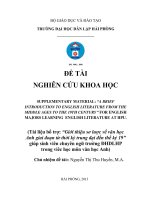Trang Phục Quân Đội Thế Kỷ 19
Bạn đang xem bản rút gọn của tài liệu. Xem và tải ngay bản đầy đủ của tài liệu tại đây (1.31 MB, 15 trang )
MILITARY
Trang Phục Quân Đội Thế Kỷ
19
Sv : Võ T. Trúc
Huyền
Lớp : 06DTT
Giới thiệu về nước Pháp
►
►
Cộng hòa Pháp, là một quốc
gia ở vùng tây Âu.
Ở thời Napoleon,đồng phục
quân đội được xem là 1 tác
phẩm nghệ thuật và ơng chi
khoản chi phí khá lớn cho
trang phục.Vì thế độ “hồnh
tráng”của trang phục khiến
ta nghĩ đến 1 nước Pháp
mạnh mẽ về kinh tế và xa
hoa. Quân đội Pháp gồm lục
quân, hải quân, không quân
và lực lượng hiến binh quốc
gia..
Quốc kỳ
Pháp
Trang
phục
quân đội
Pháp
hiện nay
Xu Hướng
Những
chi tiết
trên trang
phục
quân đội
có liên
quan
hoặc phù
hợp để
thiết kế
theo xu
hướng
thời trang
mới
Một số thiết kế dành nữ được
ứng dụng bởi các sao.
Mẫu thiết kế Gareth Pugh,
D&G, Burberry Prorsum, và
John Galliano
Nghiên Cứu Ý Tưởng
►
Qua các
thời kỳ thì
trang
phục kỵ
binh cũng
có nhiều
thay đổi
để phù
hợp với xã
hội cùng
thời.
Thế kỷ 17
Thế kỷ 18
Standard 1
►
Why People Wear Clothes
Adornment: Clothing can
affect a persons mental
attitude or morale in a
good way. This is done
through adornment or
decoration. Decorative
adornment provides a
psychological feeling of
well-being through beauty.
► Beauty
is a quality that gives
pleasure to the senses, and
gives a positive emotional
reaction to the viewer.
► The way one culture views
beauty in clothing may be
completely different than the
way one culture views beauty.
Uniforms
►
Why People Wear Clothes
Identification: Identification is the process of
establishing or describing who someone is or what
someone does.
► Uniforms are a way of identifying roles, Uniforms
identify that someone is a police officer, or a member
of the armed forces. Uniforms can decrease racial,
religious, and other barriers.
► The regular clothing people wear may be considered
“psychological uniforms”–look at your classmates,
aren’t all of them pretty much dressed alike?
► Adults dress alike, too.
►
Ceremonial garments can provide
identification-A white wedding
dress indicates a woman is a
bride. A cap and gown indicate a
person is graduating.
►
Some businesses and schools
have Dress Codes. Each article
of clothing must fall within a
range of options. Although,
garments worn are not uniforms,
they fall within a range of options.
►
Why People Wear Clothes
Modesty: Human beings wear clothing to satisfy
their social need for modesty.
► Modesty
is the covering of a persons body according to the
code of decency of that persons society. In our society, it is
embarrassing to go without clothes.
► In the 1800's it was immodest for American Women to let
their ankles show.
► In the 1920's older people were appalled at the short skirts
worn by young women
► Women's’ swimsuits were once made of thick fabric and
covered the entire body. Now fashionable swimwear
exposes lots of skin.
► The standards our society has set on modesty has changed
a great deal.
► The event you are attending also affects your modesty.
► By wearing appropriate and inappropriate clothing, people
show their acceptance or rejection of their social
environment.
► Why
People Wear
Clothes
Status: A persons status
is his or her position or
rank in comparison to
others. “Good” or
“High” status is usually
associated with
recognition, prestige,
and social acceptance.
► Clothing
is sometimes used to
gain a higher rank in society,
along with social acceptance
and peer approval.
Conformity Versus
Individuality
►
Conformity means obeying
or agreeing with some
given standard or
authority.
A safe feeling of belonging
is achieved through
approval. However, too
much conformity can mean
a loss of personal
individuality.
Individuality is selfexpression. It is the quality
that distinguishes one
person from another. It is
the characteristic that
makes one person unique.
Garment dyeing: The dyeing of
constructed garments by apparel
manufacturers to fill retail orders
for requested colors.
Printing: Process for adding color,
pattern, or designs to the surface
of fabrics.
Heat Transfer printing: Method of
printing fabric by transferring the
design from preprinted paper by
contact heat.
Calendaring: Mechanical finishing process by which
fabric is passed between heated rollers under
pressure to produce special effects such as high
luster, glazing or embossing.
Singeing: Mechanical finishing procedure of burning
off protruded fibers from yarn or fabric to give a
smooth, uniform surface.
Brushing: Finishing process in which rotating brushes
raise a nap surface on fabrics. Also called napping
Shearing: Mechanical finishing procedure where
projecting fibers are cut or trimmed from the face of
fabric.
Beetling: Mechanical finishing process for cotton or
linen fabrics that pounds them flatter, which gives a
harder surface with increased sheen.
►
Identify Eight Finishes that are applied to fabrics and explain their purpose.
Anti-static: this prevents the buildup of static electricity, so
garments will not cling to the body of the wearer
Crease-resistant: Fabrics, especially cottons, rayons, and linens,
are baked with a resin that helps them resist and recover from
wrinkles. This also makes the fabric weaker, and stains set faster
Flame-resistant: this finish prevents fabric from supporting or
spreading a flame. The fabric is self-extinguishing when removed
from the source of the flame.
Mercerization: this caustic soda treatment is used on cellulosic
textiles
Mildew-resistance: A metallic chemical is applied to fabrics to
prevent mildew from forming.
Permanent Press: A resin is applied to fabric to help it hold its
original creases made at manufacturing.
Stain Resistance: This makes fibers less absorbent, so it is easier
to lift off or sponge away spills of food, water, and other
substances.
Waterproof: A rubber or plastic coating is used to fill the pores
of fabric so that water cannot pass through it.
Water Repellant: This uses wax, metals, or resins to coat fabrics,
and cause fabrics to shed water in normal wear, but does not
make them completely waterproof.
►
►
►
►
►
►
►
Bias grain goes:
Diagonally across the fabric
“Stretch” woven fabrics:
Are woven of stretchable yarns
Pile fabrics
Have loops or yarn ends projecting from the
surface
Jacquard looms:
Weave large and intricate designs
Artificial suedes:
Nonwoven fabrics
Bleaching is a:
Chemical process that removes natural color
from textiles
Colorfast implies that:
The color in a fabric will not change
►Roller
printing
Direct, calendar, or cylinder
printing, applies color to fabrics
►Finishes:
Improve the appearance, feel,
and/or performance of textiles
►Mercerization:
Heat sets resin onto fabrics,
increases durability of fabrics,
and fills in pores of fabrics.









